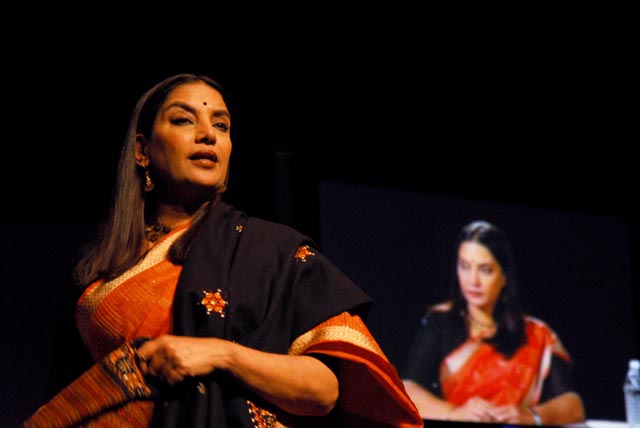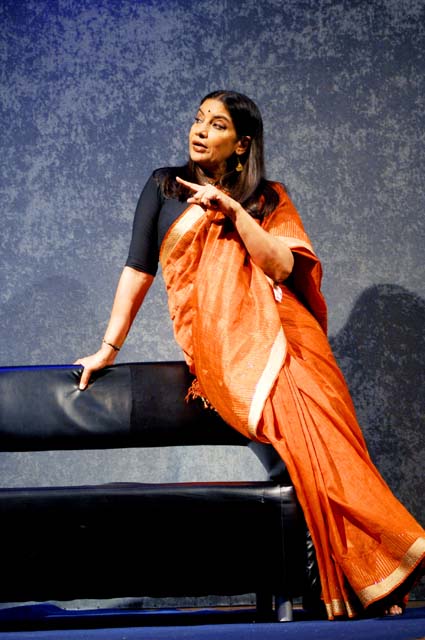
In Broken Images, Shabana Vs. Shabana
Imagine this: just one actor on stage. No set transformations, no costume changes, little or no action.
Yet you sit for a full hour, totally engrossed, and are almost surprised to find that, though you’ve sat immobile in your seat, you’ve traveled into complex worlds, into the innermost reaches of mind and heart.
Few people could pull this off but the combination of actor Shabana Azmi, director Alyque Padamsee and playwright Girish Karnad makes ‘Broken Images’ a play to watch and relish. To that, add a fourth player – digital technology. In this psychological thriller electronic images, video and television juxtapose to become another powerful force, almost a character, adding a lot to the high drama.
“When T. S. Eliot talked of ‘a heap of broken images where sun beats and the dead tree gives no shelter’ in his ‘ Waste Land’, he was obviously talking of concrete images found piled in a desert,” says Karnad, “The images that surround us—in every burgeoning Indian megalopolis— are digital, insubstantial but persistent, and the desert they define is our ‘hyper-reality’. We have all morphed into our own images.”
What’s real and what’s make-believe? The play revolves around Manjula Sharma, a moderately successful Hindi writer who has hit the big time by publishing her first novel in English. Suddenly she’s a global star. You see her in a television studio, giving one of countless interviews. She is the suave celebrity, chatting about her life and times, giving due credit to her husband and to Malini, her crippled sister who inspired her. You listen as the story unfolds – and then suddenly the television screen at the back comes alive – and suddenly you have two Manjulas on stage, each competing for your attention.
Is the second Manjula a phantom, a voice of her conscience or perhaps the spirit of her dead sister? As the two Manjulas duel mentally, you get sucked into the volatile inner drama of sibling rivalry. Your sympathies and loyalties change constantly and you really are not sure who the victim is and who is the victimized.

Broken Images: A One Woman Show
Shabana Azmi, the award-winning actress who’s acted in over 140 movies and many plays, manages to keep you thoroughly engaged right to the high crescendo of the finale. The play presented by Ketki Parikh of Vachikam in the US, was brought to New York by the organizations Bitiya and Indo-American Arts Council. After the packed New York performance, audiences were treated to a Q and A. conducted by Aroon Shivdasani of IAAC with Shabana Azmi at the end of the performance.
Asked as to what made her choose this particular script, Azmi said, “ I do think it’s a very clever script – I have great regard for Girish Karnad who is by far one of our best contemporary playwrights, and also for Alyque Padamsee, who worked with my mother 40 years ago and now works with me again. I’ve always had a horror of doing one on one shows – I’ve always found it very self-indulgent – but when I read this I found it technically very challenging, I thought emotionally it was very strong.
Raell Padamsee (the producer) had been asking me to do a play with her for six years and I couldn’t find a script which satisfied me. When I read this, I called her up and told her I would do it – and that’s how it happened. For me what was quite interesting is that I still can’t quite figure out, even after so many performances, as to who is the victim and who is the victimizer and when I asked Girish that, he said ‘Figure it out yourself! I’ve no idea!’ And so it plays differently with different audiences, it really keeps shifting balance.”
Shabana Azmi is on stage from beginning to end, interacting with her own virtual, digital self and it’s really quite a powerhouse performance: the victim and the victimized, the inquisitor and the confessor. The audience was amazed to learn that Azmi had done the televised portion all in one smooth take. “The shot is one shot and it was done in one take, the first take,” she said. “It came as a huge surprise to me – in film you don’t have a 44 minute shot!” Of course, the challenge of this performance was for the real Manjula to keep perfect timing, in lockstep with the virtual Manjula; there was no margin for errors. Says Azmi: “That’s the terror of the performance because if I miss a line or two, she’s not going to come to my rescue, whereas in theater you expect other actors to quickly make up for you – so it’s quite terrifying!”
This being a play in English, there was the inevitable question from a viewer: “Shabanaji, you’re a Hindi actress, you’re supposed to speak the language of the country!” Amidst a burst of laughter from the audience, Azmi responded, “That’s the whole point of the play in fact, that’s the whole point about the jingoism of this language and not that language! A writer seeks audiences where she or he can find them, says Girish Karnad!”
(The play travels to several cities in the US. www.brokenimagetheplay.com )
Have you seen the play? What did you think of it?
